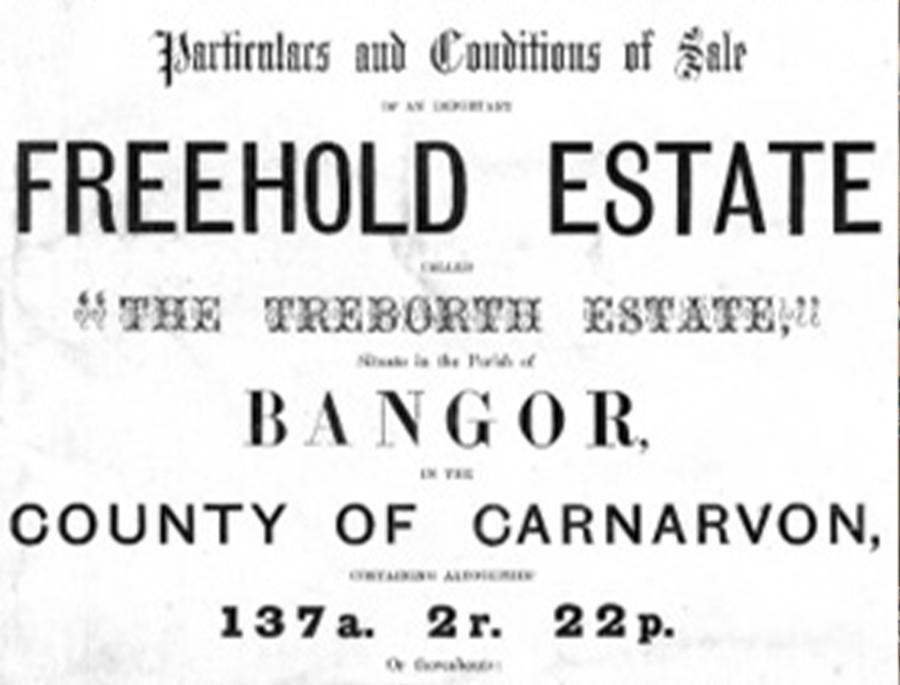In 2019 ISWE partnered with Bangor University’s Treborth Botanic Garden to co-supervise an undergraduate internship to explore the documentary evidence relating to the history of the site.
Jacob Parry, a History Student, identified several records at Bangor University Archives, the National Library of Wales and Gwynedd Archives relating to the history of the Treborth Isaf estate.

This allowed him to construct a timeline of the estate’s history, stretching back to the time of its ownership by the Fletcher family in the sixteenth century. Treborth Isaf transferred to the Brynkir family, through the marriage of the Fletcher heiress, Catherine Coetmor Fletcher, to William Brynkir in 1708. Jacob identified a heraldic memorial to Catherine Brynker in Bangor Cathedral. She was the daughter and heiress of Thomas Fletcher of Treborth esq., who had three sons with her husband, but died in 1723 aged 27. William Brynkir was Sheriff of Caernarfonshire in 1725, but from the 1730s experienced increasing financial troubles which affected the Treborth estate.
In 1833, Sarah Bicknell of the Penrhyn Arms and Bodlondeb purchased the Gorphwysfa estate ‘and land to the west’, including lands at Treborth. In 1846, Sarah’s son Henry Bicknell sold some Treborth land to the Chester & Holyhead Railway Co. for the Britannia Bridge approach and Joseph Paxton’s ‘Britannia Park’. A sale catalogue of 1867 describes the Treborth as:
‘A beautiful estate [that] enjoys and forms part of one of the finest landscapes in the locality, is charmingly diversified with fine grown timber, and commands fine views of the Snowdonian range of mountains, having the Menai Straits with its far famed suspension and Tubular bridges, with Britannia Park immediately at the Northern Boundary; its situation is so central, being close to the Menai Bridge Station on the Chester and Holyhead, and Bangor and Caernarfon railways, that as a residential property it cannot be surpassed in the Principality.’
Around this time the estate was sold to the Llangefni-born businessman and shipowner Richard Davies (1818-96), who served as Liberal MP for Anglesey from 1868-86. J. R. Davies sold the 215-acre Treborth estate in 1925, when it was marketed as enjoying:
‘Beautiful and extensive view of the coastline, the bridge, puffin island, Great Orme, and Anglesey. The mansion was built of stone, and is surrounded by mature shrubberies and plantations of ornamental specimen trees. The mansion is approached through massive entrance gates, and is guarded by a most attractive lodge which lies close to the graceful suspension bridge.’
Treborth Botanic Garden now covers an area of 18 hectares of the former Treborth Isaf estate on the shores of the Menai Strait and has been owned by Bangor University since 1960.
Reflecting on the internship, Jacob wrote that:
‘This was one of my best experiences at University. I was given a lot of responsibility from day one and felt like I was making a real impact. I was able to meet with important stakeholders, attend meetings, make assets for events, and do my own independent research. It was also just a really amazing place to work and being able to explore the Garden on my breaks was a blessing. I was lucky enough to continue working with Treborth helping to coordinate two of their events after my internship finished. I designed a community consultation survey, ran a stall at events to engage the public with Treborth plans for their Heritage Lottery funding application, and even collaborated with a lecturer from another University to produce a report about the connection between heritage, nature and wellbeing.
